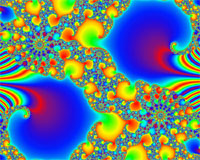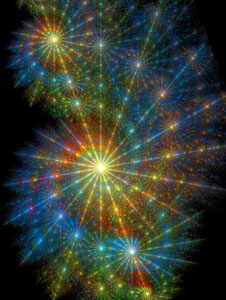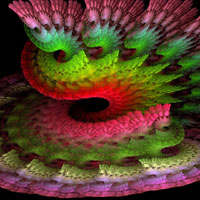3. Concepts on Light and Colour
We have already discussed Newton’s original researches into the manifestation of colour briefly. We shall now examine his theories more closely.
Newton was trying to design an accurate telescope when he discovered, almost by accident, that when sunlight passes through a glass prism, the white light which enters the prism emerged from it separated into seven different colours. With further experimentation, he found that when the spectrum thus produced was passed through a second prism it reverted to white light. With this in mind, Newton developed his Corpuscular Theory of light manifestation. This theory states that light is transmitted by a series of minute particles which reflect light one to the other.
This theory was later challenged by Christiaan Huyger’s concept, known as the wave theory. This claimed that light was really transmitted in a series of pulses so rapid that they appeared to cause a wave-like motion as they travelled across space. Does this sound familiar?
Still later, Albert Einstein, whilst developing his atomic theory, contributed further to the controversy by suggesting that since all matter was composed of atoms, light which emanated from a source such as the sun was probably transmitted via atoms through space in rapid pulses. This theory, broadly speaking, probably comes closest to the underlying hypothesis of Colour Harmonics.
However, as is often the case with scientific theorisation, the currently available concepts of light transmission are fairly unsatisfactory in their ability to provide a complete explanation. One cannot help but be left with the feeling that science has left more unanswered than it has clarified.
For instance, where did the Universe appear from? Before there was matter there must have been no matter. And what was the force which transmuted no-matter into matter? Even scientific theories about anti-matter seem uncertain. Anti-matter is not the opposite of matter - it is a thing that can only be created once matter exists. When experiments on the production of anti-matter have taken place, they have always done so from a material beginning. The very existence of matter confounds the issue. Matter is the complete opposite of no-matter and arises from it, in some way that we do not understand. Anti-matter is the complete opposite of matter and rises from it. These are not the same thing. They have different starting points. Opposites are not mirror images of their counterparts, they are states which arise from their counterparts. Opposite principles do not directly reflect the positive elements of a given state with negative ones.

Perhaps we can clarify this abstract complexity with an example which may make it easier to grasp, and with which you might like to experiment. We tend to regard black and white as complementary opposites. We’ll accept this idea for now. Take a small glass of milk (not the last in the fridge because you won’t be drinking it later!), a bottle of ink and another larger glass. Empty half the glass of milk into the larger glass. See this as no-matter. Now add a teaspoon of ink. Let’s call the resultant murky substance matter. Now add the other half of the glass of milk. The paler grey shade can be taken as anti-matter. You can see that this is not the same as no-matter.
Science therefore has taken us no closer to an understanding of how our Universe works. Perhaps the answers to such questions lie, not in the factual world of science, but in the realms of intuition and imagination. And so, with this in mind, we should return to our study of colour.
The light spectrum contains seven colours: red, orange, yellow, green, blue, indigo and violet. These seven colours provide the basis of Colour Harmonics, and indeed, of all colour comprehension. Of course, one colour can appear in an almost limitless range of shades and hues. Red, for instance, appears as palest petal pink all the way through to deepest scarlet. All of these shades have their own effects upon the thinking patterns and psychology of those people who view them.
In addition to the basic spectrum, in Colour Harmonics we also pay attention to certain other colours, particularly where therapy is concerned One of these is turquoise, which is, of course, a blend of blue and green, and holds some of the qualities of each of those colours. However, turquoise also has specific qualities of its own which are in some ways the result of the harmony of opposites discussed earlier. In the healing area this subtle blend of separate shades is important because of their combined effects. There are higher analogue colours as well, like pink, peach and apricot which are especially valuable. This is true also for the colours we use to decorate our homes, and work environments, which make a big contribution to our overall health and well-being.
Two other important colours with which we are concerned are not exactly colours at all - but are the representation of light in its pure form, or the lack of it. I am referring to black and white. Although these two are generally accepted as ‘non-colours’ for the sake of simplicity (and with all apologies to the purist) we shall refer to them as colours. Still as we said earlier, even referring to the spectrum as colour is a misconception!
Each colour may be broken down into three general categories - the true colour, which is the clear, bright version of the hue which sits in the centre range of its shade variation. The true colour contains all the basic qualities of the colour in their undiluted and unaltered form. From the true shade a colour does one of two things - it gets lighter or darker. Its influence is tempered accordingly.
It’s very important to remember that there is no such thing as a ‘bad’ or ‘evil’ colour. Since colour is a visible manifestation of light it would be improper to make judgements about its concentration, or even about its absence. This is a basic concept which cannot be stressed too much. There has been much talk in recent years about ‘good’ and ‘bad’ colours.
The fact is this - light, and therefore colour, simply ARE. The same applies to darkness, or black. Light, and its absence, are natural manifestations of a physical Universe. They are above and beyond an obsessive need to judge as right, or condemn as wrong. They exist. If there is any element of right or wrong to be examined within the context of colour-consciousness, that element must be applied where it belongs - with the being who responds to the force, not with the force itself. In fact, this particular concept could be applied to most types of energy. Take electricity for example - when harnessed and regulated in a domestic or industrial situation its contribution to our lives is invaluable. When occurring naturally as bolts of lightning, its force is awesome. But either way, we don’t blame electricity when we get a shock - we accept that if we touch live wires or are struck by lightning, we will be shocked. There are many forces, energies and powers in our Universe which operate on this principle. It is essential that we take responsibility for our perception and use of them, for only in this way can we apply them to their maximum efficiency and our maximum benefit.

Lighter shades of a colour reflect more light than do their true counterparts. It could be said that white has been added to the original shade, and therefore the tone takes on some of the qualities of whiteness. The basic interpretation of the colour is tempered and adjusted by the addition of white - the lighter the shade the stronger becomes the white influence. Lighter colours are used a lot in a healing context, and are often easier to live with psychologically than their darker cousins. As a general rule, the lighter a shade is, the more spiritual becomes its definition and effect.
Darker shades of colours absorb more light than the true colours. Here you can imagine that you are withdrawing light - or adding black as a representation of darkness. Darker shades have less general use in healing, and tend to relate more to the material aspects of life. Again I must stress that this is no bad thing. So long as an individual lives in a material world, matter assumes no little importance in life. This is an obvious and yet much misunderstood fact. Quite simply, harmony lies in the achievement of an even balance between the material, mental, emotional and spiritual elements of human existence. Too much of anything is a bad thing, as is too little. It is by finding the point of balance that freedom and happiness are to be attained.
In the study of colour, there are several different factors which must be considered. There is the psychology of a given colour - the broad base of effect a particular shade most usually evokes when it is shown to people. This is basically an outside-in effect - that is, the colour forms part of one’s outer environment, and works its effect via sight and perceptive processes. Then there is the emotional level at which a given colour works. This is one’s own response to colour exposure. This response will be subjective, taking into account personal experience, the process of association, and individual interpretation. This is an inside-out effect - a personal and intimate response to exposure to a given colour. Each of these effects generally tends to happen at the same time - without first being subjected to the outside-in effect, you may not establish an inside-out response.
But colour also occurs spontaneously within our own minds. Shut your eyes, and watch the colours begin to build up behind your eyelids. Our emotional reactions to a given colour temper our basic psychological reactions. For instance, if two people are shown the same shade of red under the same conditions, each will be stimulated by its specific energy. However, if one of those people is already nervous, hypertensive or under acute stress, the emotional response to the colour will probably be quite negative. If the other person is fatigued, the stimulation may be welcome, causing positive reactions.
In addition to the response of the minute, we also acquire preconceptions about whether we like a particular colour, and this can also affect our emotional response. Such prejudices about specific colours can often be detrimental to us. In truth, we are multi-coloured creatures, and have ever-changing needs with regard to colour, so it’s helpful to cultivate an open-hearted and unbiased view of all colours. Try, if you can, to regard colours as positive so long as they are used appropriately. If you do discover yourself nursing a real dislike of a given shade or colour, try hard to work out why. Later in the Course there will be exercises that may help you to isolate the root causes of such reactions - and an exploration of one of my ‘pet hates’ which might help you to discover why you may develop an abreaction.
For many thousands of years before man made his scientific discoveries about colour, it had been used most richly in art, myth and legend. By studying some of the mythological attributions of colour, it is possible to acquire insight and enlightenment about the deeper meanings of colour in life. So we will also examine some of the mythological correspondences to colour.
Then, of course, we must consider our application of colour - which wall should we paint red? When should we wear blue? You will find we have attempted to cover the spectrum, taking into account each of the above considerations, in order to develop within you a working understanding of each colour, and the ways in which they act together.

